AMD Ryzen 5 2400G and Ryzen 3 2200G Core Frequency Scaling: An Analysis
by Gavin Bonshor on June 20, 2018 10:05 AM EST- Posted in
- CPUs
- AMD
- Zen
- APU
- Vega
- Ryzen
- Ryzen 5
- Ryzen 3
- Scaling
- CPU Frequency
- Ryzen 3 2200G
- Ryzen 5 2400G
Discrete Graphics Performance, Cont
As stated on the first page, here we take both APUs from 3.5 GHz to 4.0 GHz in 100 MHz increments and run our testing suite at each stage. This is a 14.3% increase in clock speed, however when it comes to gaming it can be unpredictable where those gains are going to come from.
For our gaming tests, we are only concerned with real-world resolutions and settings for these games. It would be fairly easy to adjust the settings in each game to a CPU limited scenario, however the results from such a test are mostly pointless and non-transferable to the real world in our view. Scaling takes many forms, based on GPU, resolution, detail levels, and settings, so we want to make sure the results correlate to what users will see day-to-day.
Thief
Thief has been a long-standing title in the hearts of PC gamers since the introduction of the very first iteration back in 1998 (Thief: The Dark Project). Thief is the latest reboot in the long-standing series and renowned publisher Square Enix took over the task from where Eidos Interactive left off back in 2004. The game itself uses the UE3 engine and is known for optimised and improved destructible environments, large crowd simulation and soft body dynamics.
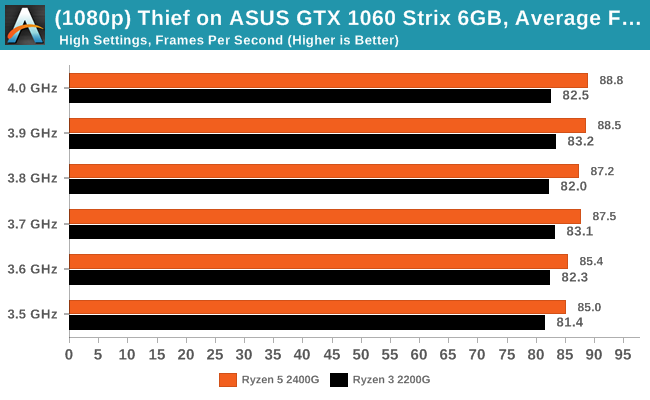
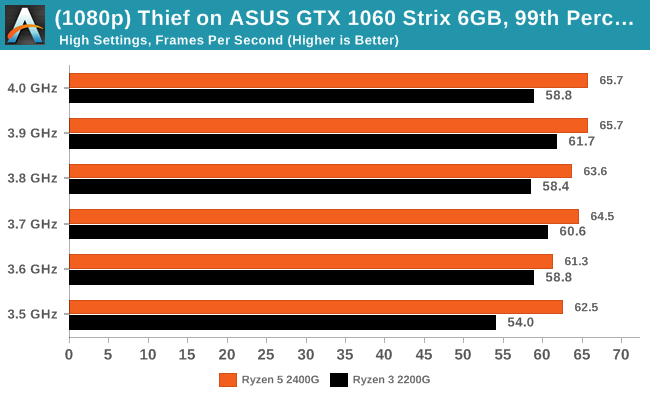
Shadow of Mordor
The next title in our testing is a battle of system performance with the open world action-adventure title, Middle Earth: Shadow of Mordor (SoM for short). Produced by Monolith and using the LithTech Jupiter EX engine and numerous detail add-ons, SoM goes for detail and complexity. The main story itself was written by the same writer as Red Dead Redemption, and it received Zero Punctuation’s Game of The Year in 2014.
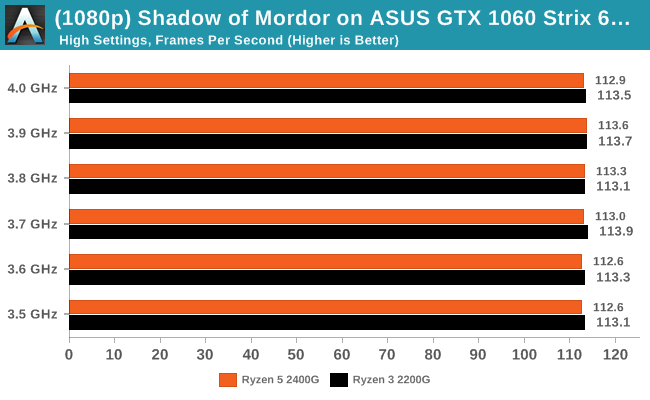

F1 2017
Released in the same year as the title suggests, F1 2017 is the ninth variant of the franchise to be published and developed by Codemasters. The game is based around the F1 2017 season and has been and licensed by the sports official governing body, the Federation Internationale de l’Automobile (FIA). F1 2017 features all twenty racing circuits, all twenty drivers across ten teams and allows F1 fans to immerse themselves into the world of Formula One with a rather comprehensive world championship season mode.

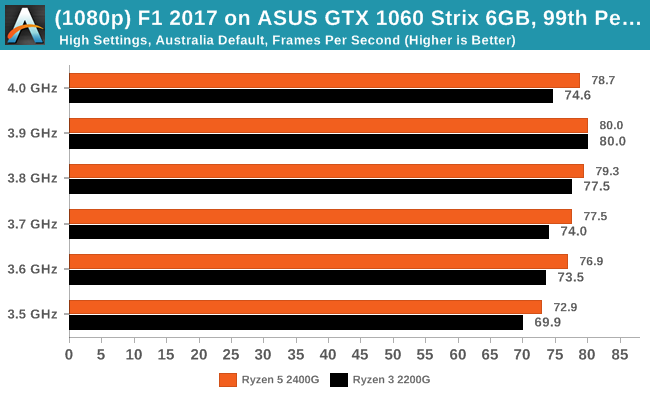


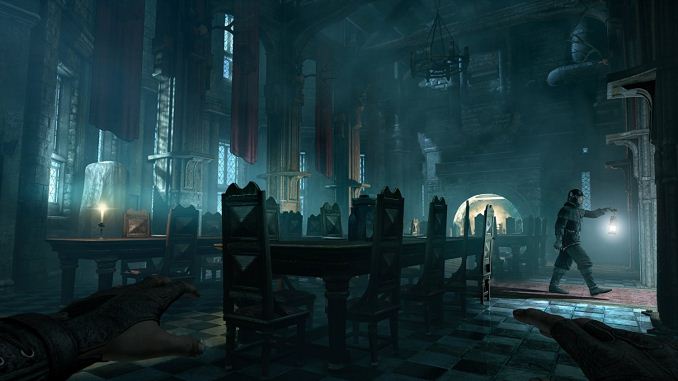

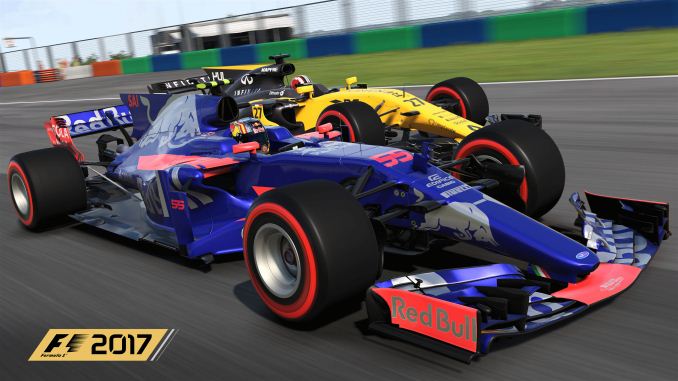








29 Comments
View All Comments
eastcoast_pete - Wednesday, June 20, 2018 - link
Gavin, if I read this analysis correctly, this expands on your previous article on CPU core scaling of the 2200G and 2400G, both delidded, but not on iGPU overclocking. Since all graphs are in the 3.5 -4 Ghz range, I assume that this is all for CPU speeds, including the IGPU labeled data. If I am wrong, please correct me, but if you managed to overclock the VEGA cores to 4 GHz, it would be quite a feat!I have a couple of questions:
1. Power and thermals in the various use scenarios? Maybe not for all of them, but some cornerstones to get an idea; if you used the data from the first article, please mention or link to that.
2. What about selective overclocking of the iGPU, especially iGPU only? The key attraction of delidding the 2200 and 2400 for me is a potential to boost the iGPU performance. The stock speed of the CPU is fine IMO.
3. Any information or planned follow-up on undervolting/underclocking the CPU, and boosting iGPU using the stock cooler? If possible, both before and after delidding.
The last question relates to another article here on the best gaming CPUs. Now, some of us can afford a $2000+ rig - and power to them. However, the big challenge really is at the other end. The value king of the "best CPU.." in the $ 500 and under group, the 2200G (or 2400G, if you have a PSU and a disk that can be reused for the new build), really have the much better iGPU going for them vs. price-matched Intels. So, any data on iGPU overclocking coming up? I believe I am not the only one waiting - Thanks!
gavbon - Wednesday, June 20, 2018 - link
Hey Pete, it's essentially following on, with memory scaling also not far off being published (near future depending on schedules etc). I'm actually setting the test bench back up to finish the iGPU scaling piece off which I intend to answer a lot of questions asked from the overclocking piece.To answer your questions directly:
1. Power wasn't much of a factor in this piece as the focus is primarily on CPU frequency scaling, with power consumption being touched upon on in the previous articles.
2. iGPU scaling piece is being worked upon currently, with the test bench being set up tomorrow or Friday (just working on some motherboard reviews today as well as balancing a severe hand injury which has hindered me for the last few weeks).
3. I didn't have a planned follow up planned with a stock cooler, as my aim was to essentially show scaling without much limitations on things like cooling; the stock cooler would obviously generate more heat and I didn't want that to be a limiting factor at any stage.
4. I made a post on my personal Facebook page about Ian's Best Gaming CPU Q2 article just published. My first reaction was the $500 system with the Ryzen 5 2400G made me smile inside as I genuinely think the 2400G is a stunner for the price, especially for gamers on a budget with certain limitations.
The crux is, iGPU scaling is coming, sit tight :D
eastcoast_pete - Wednesday, June 20, 2018 - link
Hi Gavin, thanks for your response! Firstly, sorry to hear about your hand injury, and wishes for a speedy recovery.Look forward to your iGPU overclocking review. If you can, please try it also while undervolting the CPU, so more thermal headroom is available for the GPU.
gavbon - Wednesday, June 20, 2018 - link
I try my best! I fell on a glass and needed 2 and a half hours in surgery to re-attach the tendon in my index finger; was completely severed! - Really appreciate your well wishes! It's on the list, it will be mentioned, don't worry :DSpunjji - Friday, June 22, 2018 - link
Ouch! Heal up well! :)MrSpadge - Wednesday, June 20, 2018 - link
Gavin, I think you should also show the negative scaling in the summary, instead of setting it at 0.00%. What happens is probably that the CPU is eating more into the iGPU power budget at higher clocks, so the average iGPU frequency is reduced.eastcoast_pete - Wednesday, June 20, 2018 - link
Good point. A lot of the iGPU data here really suggest that the performance in a number (all?) games is mostly or entirely GPU-limited, so the 11CU 2400 is always a bit ahead of thr 8CU 2200. Plus, your point on iGPU throttling due to the overclocked CPU cores using up thermal headroom is born out in some of the data, where frame rates show a slight drop at maximum CPU speed.lightningz71 - Wednesday, June 20, 2018 - link
I am still hoping for an article that looks at bclk (base/bus clock) overclocking with the 2200g/2400g. I still think that optimum performance can be had from them by getting the iGPU just past the clock hole between 1300-1500Mhz, then overclocking the ram to 3200-3333 Mxfr, and then nudging the bclk up as high as it can go without causing instability or turning off turbo boost.Lolimaster - Friday, June 22, 2018 - link
Best combo:2400G turbo disabled
3200 CL14
1500Mhz+ igpu
Undervolt cpu (just the cpu part) as this APU's lets you undervolt cpu and gpu independently.
CM Hypeer 212 EVO/X is more than enough for the system, even better if delidded.
Delid+metal just to get good temps with the OCed igpu
boozed - Wednesday, June 20, 2018 - link
WinRAR: "it would seem that other factors came into play with the 2200G"Okay... so what are they?